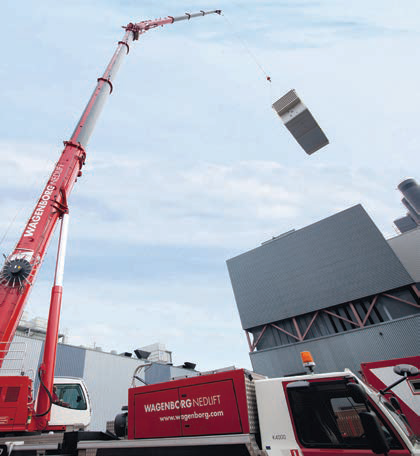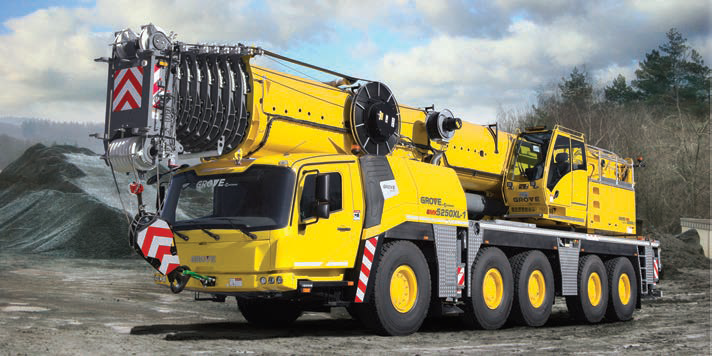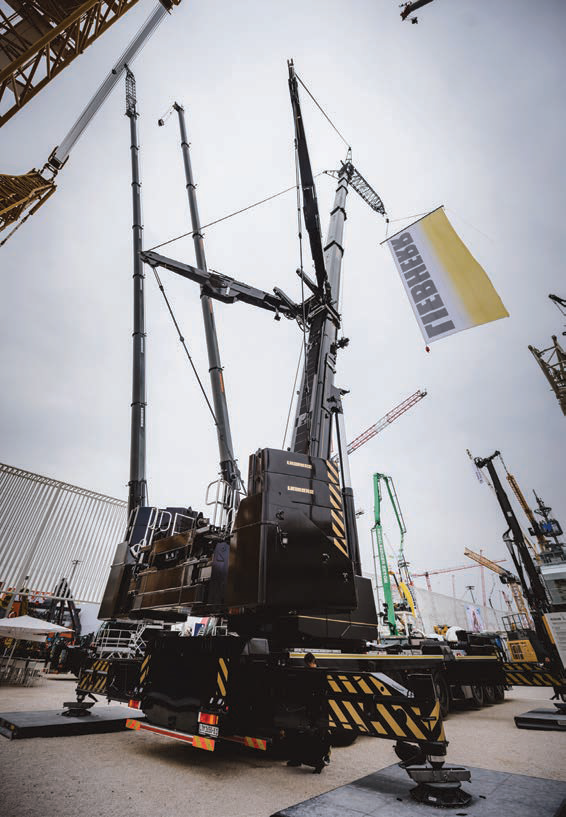The long and the short of it
17 July 2019At this year’s Bauma, Manitowoc launched a series of long boom versions of its cranes. It’s not an entirely novel strategy, but one that the US firm has followed across more of its range than any other. Will North asks the big four global all terrain manufacturers how they meet different demands for reach and capacity.
At Bauma, Manitowoc launched L-designated versions of two of its all terrains, the GMK3060-L and GMK5150-L, and an XLdesignated version of its already long boom GMK5250L, along with an L-version of its GRT655 rough terrain. Manitowoc and other manufacturers have previously offered L-versions of lower and medium capacity cranes, such as Demag’s AC100-4L, and Tadano’s ATF70G-4 in 44m and 52.1m boom versions. At the other end of the capacity scale, Demag’s AC1000 is offered with a 50m boom with a ‘bolt-on’ 50m long boom; and Liebherr’s LTM 1650-8.1, launched at Bauma, can be supplied with a long boom, sections of which can be swapped in and out as needed.
So, it is not an entirely novel concept to offer cranes with longer booms than standard, or to offer cranes with the same axle and capacity designations in standard and L-versions. But Manitowoc did break new ground in its marketing strategy to offer so many L-designated cranes at once.
Andreas Cremer, global product director, all terrain cranes, at Manitowoc, explained the thinking behind the launches. “The GMK3060L as successor model of the GMK3060 was well received by customers during Bauma. Building higher buildings and houses, the longer boom can be of advantage. Very often the load which needs to be lifted is not critical for the capacity of a crane, so it is just a matter of how to get there in an efficient way. With a longer boom this means that a smaller crane can be used for the same job or it could avoid rigging a swingaway which saves time and sometimes is difficult to do due to space constraints. Paired with the compact dimensions, the crane can easily reach jobsites in city centres or areas that are densely populated, downtown job sites or congested projects. Growing urbanisation fosters the need for small, compact but strong cranes. In addition to the increased boom length, the load chart has improved, too, giving customers access to more jobs.”
In the five-axle class, Manitowoc offers a standard and long boom version of the GMK5150. Here, while the total system length is the same at 88m, the GMK5150L offers a 60m main boom, versus the 50.8m boom on the standard version. Cremer says, “Compared to the GMK5150L, the GMK5150 can be regarded as a smaller but stronger crane. It can be helpful when lifting concrete blocks. The GMK5150L is his ‘longer brother’. The load charts of the GMK5150 are a bit stronger and in addition the gross vehicle weight is lighter which makes a difference when it comes down to road regulations in various countries.
“It might be the case that one rather uses a crane with a longer boom without additional jib to save setup and dismantling time. This can fulfil customer needs if cranes were used at several jobsites during a day. In general, we offer a variety of products in our portfolio to meet the needs of our customers best.”
Finally, and also in the five-axle class, comes the GMK5250-XL1. This crane reaches 78.5m of main boom, 8.5m more than on the 70m GMK5250-L. Cremer says, “With 78,5 m boom length, the GMK5250XL-1 has the longest main boom in its class and pushes past boundaries. Yes, it can be used for maintenance work on wind turbines but also for the setup of tower cranes and for every job that has the following requirements: You need to be able to lift high plus you need to be able to reach a narrow jobsite area where space is limited (e.g. petrochemical plants, refineries). In addition, the GMK5250XL-1 is roadable easily as driving permissions will be issued for this crane that meets axle load restrictions. All in all, it is the most powerful and versatile five-axle crane in the market. Similar to the GMK3060L it helps on sites where it is just a matter on how to get the load to a certain height in a very efficient way helping our customers to improve their ROI.”
As Cremer makes clear, there is a trade-off between standard and long boom cranes. At the job site, a standard boom crane will generally offer more capacity across the load chart; and, when travelling between job sites, a standard boom version may be more easily roadable. Conversely, a long boom will—obviously—reach further, and can often be used without any time being spent fixing jibs.
Liebherr Ehingen has chosen not to offer cranes of the same designation in L-versions. The company’s marketing manager Wolfgang Beringer explains, “We want to get the maximum out of a crane concept. This goal can only be reached if one develops a crane without compromises, and not by offering two different boom lengths on one crane model with 12t axle load. The Liebherr LTM concepts with two booms are always linked with different axle loads and gross weights.”
Demag and Tadano too seem to prefer this approach, developing each ‘crane concept’ separately. For example, in the six-axle class, Demag has the 300t 80m AC 300-6 and 350t 64m AC 350-6. At a glance, one might consider these 'strong' and 'long' cousins. But product marketing manager Michael Klein says these two cranes have a distinct design ancestry and concept. “I would not compare the AC 300-6 and AC 350-6: the AC 300-6 is the successor of the AC 250-1, which already had an 80m main boom. We still see the need for shorter boom cranes, because of certain applications, [such as] heavy lifting and luffing jib operations.”
So, while Manitowoc’s use of the L-designation may be a helpful guide when first choosing between similar cranes in the Grove all terrain range, it’s only a guide. Along with calculating whether rental rates will cover finance costs, and judging whether you will be well supported by aftersales and service, carefully checking the load chart, set up times, and roadability, will always be key to making a profitable crane purchase.
Material conditions
At the same time as Manitowoc was launching its L-designated cranes, steel manufacturer SSAB was launching a new version of its 1100MPa steel plate, Strenx 1100 Plus. The company’s high strength steels are regularly used across the lifting industry for boom sections. With Strenx 1100 Plus, the Swedish steel manufacturer explicitly targets the lifting industry, boasting that the new steel offers ‘exceptional weldability’.
Forming and welding booms is a highly skilled task. Stronger, thinner, steels ‘bounce back’ from the impact of a boom forming press. Welding together the 4-6mm thick top and bottom boom shells requires incredibly precise work. So, advances in steel technology certainly play a role in crane manufacturers ability to offer long, strong booms on roadable cranes.
Cremer says, “Steel as the basis of our boom production is one of the most important input factors during the manufacturing process. Thus, the availability of excellent quality steel helps us building excellent cranes. Regarding the boom manufacturing, we can state that by using high-quality steel for our products paired with modern manufacturing techniques, a reduction of weight becomes possible. Thus, we are able to design longer booms meeting the same overall weight restrictions.”
Beringer agrees, “The increase of the steel strength always led to increased boom lengths as well as to higher lifting capacities. With the use of new and more accurate calculation methods it is possible to make use of the higher steel strengths.”
It’s not, though, merely the case that having new steels leads to longer booms. Andreas Hofmann, head of R&D at Tadano, says, “New steel is helpful in the manufacturing process. However, it is not a revolution and does not necessarily lead to stronger and better cranes.”
The decades of experience, strong local supply chains, and modern computerised design techniques available to German all terrain factories all play a vital part in maintaining their global position. But strong steel, and the facilities to handle it, are also key to building highly-optimised long boom cranes. Both in their own facilities, and in collaboration with boom forming specialist suppliers, manufacturers are looking to new techniques.
Beringer explains, “The weld warpage increases with thinner boom shells. Before the introduction of new materials a high number of samples and tests have to be performed. The welding parameters have to be adapted to the new steels and the welders have to be trained.”
Cremer says, “The preparation and handling of steel is a highly complex process. At Manitowoc skilled and experienced workers are performing these tasks. In addition, they make use of modern techniques as for instance laser hybrid welding to achieve best results in handling steel and manufacturing booms. The main difference is more in the preparation and preheating of high strength steel prior to welding. Here we also benefit from our laser hybrid welding technology which induces less heat into the steel during the welding process.
“In 2013, Manitowoc advanced crane manufacturing by introducing the industry’s first laser welding boom production line. The boom production process in Manitowoc’s facility in Wilhelmshaven uses state of the art laser hybrid welding techniques. In our laser-hybrid welding unit, a robot welds the boom shell`s longitudinal seams fully automated. This process combines the advantages of laser welding with conventional welding techniques. The two half shafts are welded ensuring highest possible degree of precision. In addition, this method provides less thermal distortion of the components than conventional welding procedures to meet consistently high standards of quality. In addition, the weight of the boom is optimized using this modern welding technique.” Chris Keence, of CK Crane in Union, Missouri, chose a Demag AC 1004-L to handle growing demand from the cell tower sector. With a 59.4m boom on a compact four-axle carrier, the crane was the best fit for these jobs.
Chris Keence, of CK Crane in Union, Missouri, chose a Demag AC 1004-L to handle growing demand from the cell tower sector. With a 59.4m boom on a compact four-axle carrier, the crane was the best fit for these jobs.
 Tadano’s HTLJ, or hydraulic telescoping luffing jib lets users reach not only higher, but further out. Andreas Hofmann points out that long booms with thin steel not only pose a challenge while fabricating the boom, but when using it: the boom will deform, like a fishing rod. The company’s ‘Lift Adjuster’ aims to help operators account for this movement when lifting.
Tadano’s HTLJ, or hydraulic telescoping luffing jib lets users reach not only higher, but further out. Andreas Hofmann points out that long booms with thin steel not only pose a challenge while fabricating the boom, but when using it: the boom will deform, like a fishing rod. The company’s ‘Lift Adjuster’ aims to help operators account for this movement when lifting.

